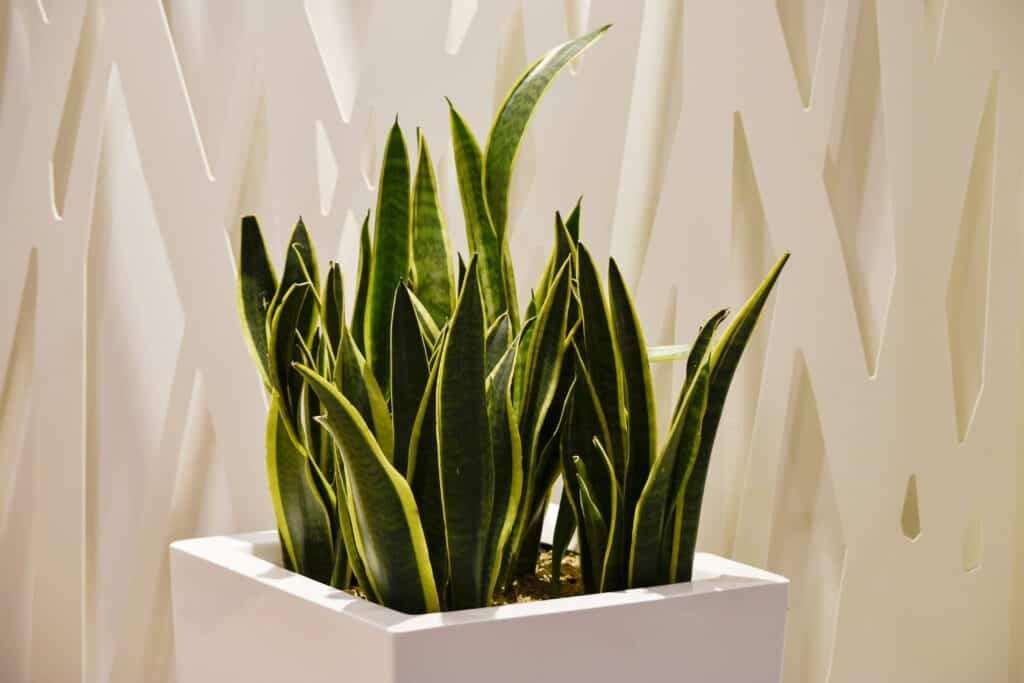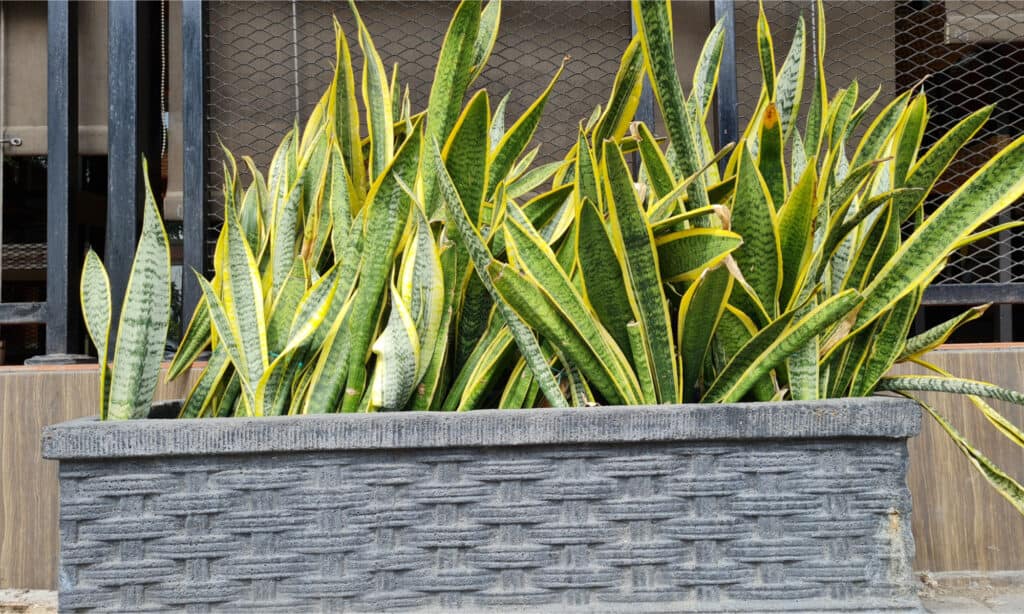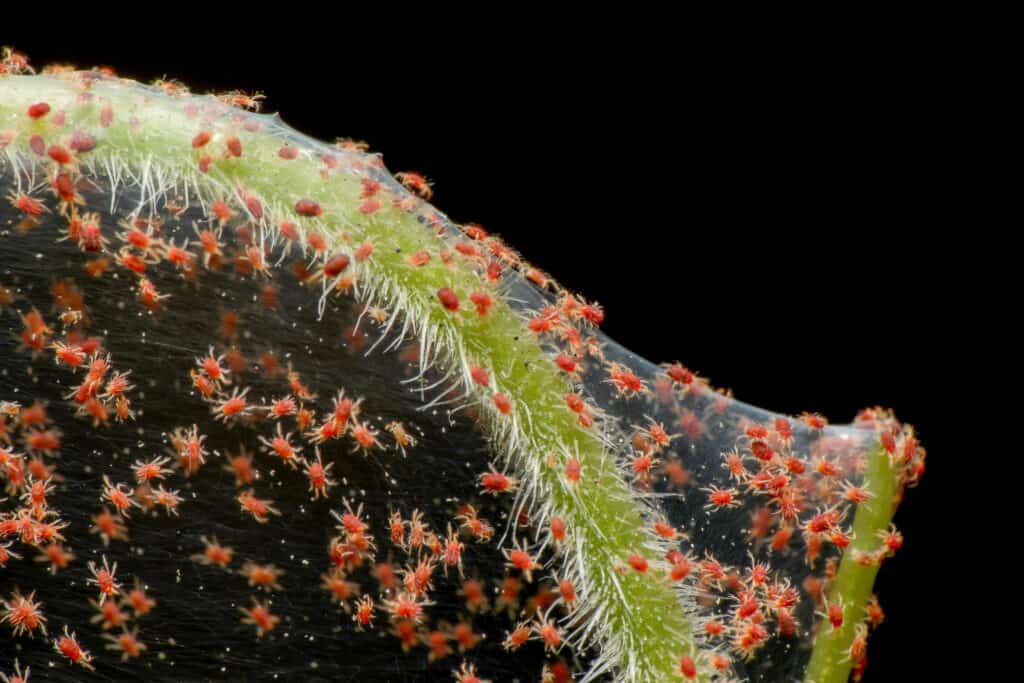Popular snake plants are one of the most stylish and resilient houseplants you can own. They need very little care and always look fabulous with their upright snake-like fleshy leaves. However, with great houseplants comes great responsibility! How often do you water a snake plant? What about light requirements, and can you go on holiday without employing a plant sitter? This article will provide all the critical care tips to enjoy a snake plant without stress.

Resilient snake plants are one of the easiest houseplants to look after.
©Olena758/Shutterstock.com
What Is a Snake Plant?
Although it sounds like Medusa’s houseplant or a dangerous snake/plant hybrid, the name refers to its magnificent rearing leaves. A snake plant has stiff fleshy leaves that grow directly from the soil and point skyward. No doubt you’ve seen Grant Wood’s 1930’s classic painting American Gothic, but if you look closely, there’s a snake plant on the porch.
As well as imbuing works of art with architectural form, one of a snake plant’s outstanding aspects is its effectiveness at removing air toxins. It’s one of the top air-purifying houseplants that help rid your home of nasties.
Before we jump into watering requirements for architectural snake plants, let’s learn a little about this epic plant because that’ll help us understand its needs. Caring for a plant is all about understanding its native environment and how it interacts with nature. Once you’ve cracked that, plant care is easy. Luckily for us, a snake plant is one of the simplest.
Native Range
Native to arid West Africa, this swordlike plant grows from Nigeria to the Congo. It chiefly grows in the shade of larger plants or rocks where it receives light, but not direct burning sun. This area of the world doesn’t receive a lot of rainfall, which is why succulent snake plants store water in their thick leaves.
Appearance
Depending on its species, a snake plant reaches six inches to around eight feet tall, but each leaf reaches no more than an inch or two across. Its stiff leaves grow from a base rosette hidden beneath the soil line, and it spreads via a creeping rhizome with tiny new pointed leaves poking their way through. Various color snake plants exist, but they all display some form of green.
Each fleshy leaf has a small twisted point. Be gentle with it because once this snaps off the leaf stops growing.

Snake plants reach six inches to eight feet tall depending on the species and its growing conditions.
©Aquarius Studio/Shutterstock.com
Toxicity
Snake plants are toxic if eaten, so it’s important to keep them out of the reach of pets that like to chew or children that might want to play with their tactile leaves.
Flowers
Yes, snake plants flower, but on houseplants, it’s rarer than rocking horse poop. Snake plants are most likely to produce flowers outside in hot zones.
Depending on the variety, snake plant flowers appear as small white tubular blooms on three feet tall stalks or clustered around the base rosette. You may catch the scent first because the perfume is intense.
Cultivars
First cultivated in China, snake plants were popular because they were thought to bring blessings to those who cultivated them. Perceived benefits included strength, health, poetry, art, beauty, intelligence, prosperity, and long life. If you didn’t want a houseplant before, perhaps that convinced you!
The cultivar “Laurentii” is possibly the most popular snake plant cultivar with its rich mid-green yellow margined leaves. It’s an absolute classic.
Other popular cultivars include:
- Boncel: Compact and chubby with fanned-out green mottled leaves.
- Black Coral: It’s not black, but the darkest snake plant you can buy.
- Birds Nest: Its short and fat funnel-shaped leaves form a rosette.
- Zeylanica: With deep green variegation this one is elegant and an interior designer’s dream.
Versatile snake plants are also on sale braided, curled, and grown at right angles for an unusual architectural statement.

Bird’s Nest snake plant cultivars grow in a rosette formation.
©Bilalstock/Shutterstock.com
Is Mother in Law’s Tongue a Snake Plant?
Yes, it’s a rather unflattering name that’s due to its sharpness. Other common names include “St. George’s sword” and “Viper’s bowstring hemp.”
A snake plant is part of the Asparagaceae family, and its botanical name is Dracaena trifasciata. Until 2017 the official name was Sansevieria trifasciata, and you’ll find plenty of sellers who still call it Sansevieria. Old habits die hard!
How Often Do You Water a Snake Plant?
So, that’s a quick rundown of this spiky, easy-care houseplant. Let’s take a look at how much water it needs.
We know the snake plant’s native range is West Africa, and that region doesn’t receive a lot of rainfall, so succulent snake plants have evolved to cope with drought. They achieve this by storing water in their fleshy leaves. This is the biggest clue about how often they need water in the wild. However, how often you need to give houseplants, water depends on the season, pot size, and where it grows.
Snake plants do not like soggy roots. Its roots must dry out between waterings, or it will simply rot. The best way to check is by touching its soil, so push a finger into the compost:
- It’s wet on top or down to an inch: No water
- It’s dry: Water required
Testing the soil once a week will tell you what it needs, but for mature plants, it’s likely to be at least several weeks between waterings.
Snake plants drink more in the summer because they’re actively growing, so the soil will dry out faster then. Small pots, pots near radiators, and pots on a sunny windowsill will dry out much faster than large pots or pots in the shade.
Judging the pot’s weight is another easy way to tell if a snake plant needs water. If it feels light, then chances are it needs water. Do the finger test to make sure.
How to Water a Snake Plant
The best way to water any houseplant is by soaking it in a sink for several hours rather than applying water from the top:
- Remove the liner pot from the display pot
- Place it in a few inches of water
- Leave it to soak up what it needs for several hours
- Place it on the draining board
- Let it drain for another few hours
- Replace it in the display pot
This method works well because it ensures a snake plant doesn’t sit in a pot of water for days on end. Remember that soggy soil rots the roots. Experts say that overwatering is the number one houseplant killer.
When it’s enjoying a drink, you can wipe the dust away from its gorgeous fleshy leaves with a damp cloth. This helps photosynthesis and boosts its overall health.
It’s pretty difficult to underwater a snake plant, but if you’ve ignored it for months, you might notice shriveled leaves with black tips instead of smooth, shiny ones.

Only water a snake plant when the soil has dried out to avoid root rot.
©iStock.com/ByronOrtizA
7 Critical Care Tips for Happy Snake Plants
This houseplant is one of the easiest to grow because it’s almost indestructible unless it’s overwatered.
Here are a few more critical care tips for beautiful snake plants.
1. Best Container for a Snake Plant
Snake plants (Well, all houseplants) need two pots.
The first pot is an unglamorous liner pot. This is the type all plants arrive in and its job is simply to hold the soil, not to look good. It MUST have drainage holes. This is the pot you’ll take out for watering purposes once the soil has dried out.
The second pot is a display pot. It should measure an inch or two wider than the liner pot, so it’s easy to get in and out. Anything goes with a display pot, so you can choose whatever you like. However, because snake plants are top-heavy (the fleshy leaves can grow several feet tall), choosing something heavy is best to counterbalance its weight. Terracotta, china, or clay are heavier materials than plastic.
2. Best Soil for Snake Plants
Fast-draining aerated soil is a snake plant’s favorite. Imagine soil in arid West Africa — that’s what you’re looking for. It’s best to create a 50/50 mix of houseplant compost and perlite or sand so it doesn’t hold moisture around the roots. Remember, moisture is held in a snake plant’s fleshy leaves; it doesn’t need consistently damp soil like ferns.
If you don’t fancy the hassle, you can purchase ready-made succulent soil, which is a mixture of compost, perlite, sand, and often coir. Cactus compost works well too.

A fast-draining cactus or succulent mix is perfect for snake plants.
©iStock.com/naramit
3. Light Requirements
In its native environment, a snake plant prefers to grow in a light, warm spot shaded by direct sun.
Choose a spot in bright indirect light, and it’ll thrive. Direct light will blister its thick leaves, and although it’ll cope with full shade, a snake plant’s color will fade and won’t grow quickly there.

Snake plants thrive in bright, indirect light but their color fades in full shade.
©Andri wahyudi/Shutterstock.com
4. Fertilizer Requirements
All houseplants need fertilizer because they quickly use up all the available nutrients from their pot. In summer, use a weak cactus plant fertilizer. Follow the label’s instructions because too much will poison your snake plant.
A snake plant doesn’t need fertilizer in winter.
5. Keep It Warm
It hails from warm West Africa, but snake plants are not that fussy over temperature. They generally prefer 65 to 90 degrees Fahrenheit, so most centrally heated houses are warm enough to keep them happy. Unlike leafy green foliage plants, snake plants do not need humidity, so misting them is unnecessary.
However, snake plants don’t like consistent drafts (none of us do!), so keep them away from open windows during winter.
6. Dealing With Pests and Diseases
Although a snake plant is generally healthy and disease resistant, a few pests and infections may launch an attack. To manage the situation, check its leaves every time you water it.
Here are a few pests that might find your snake plant appetizing:
- Aphids: Vampire aphids suck sap from the fleshy leaves.
- Spider mites: More vampires! Spider mites suck sap and build fluffy white nests in crevices.
- Thrips: You’ve guessed it, more vampires, but thrips cause curled or deformed foliage.
To get rid of them, drip neem oil or rubbing alcohol on a cotton wool pad and thoroughly rub the foliage. Spraying insecticidal soap works well too.
Diseases that might pop up include:
- Southern blight: This fungus causes leaf yellowing and droop. Remove all the affected leaves, re-pot, and use a fungicidal wash.
- Root rot: Overwatering causes root rot and it’s often game over at this point. A last-ditch attempt of leaving it dry out might improve matters.

Miniscule spider mites drain a snake plant’s sap and build fluffy white nests in the crevices.
©BirdShutterB/Shutterstock.com
7. How to Repot a Snake Plant
Snake plants grow slowly, so they need infrequent repotting. Check for exposed roots poking through the drainage holes each time you water. If you spot any, consider repotting it.
Repotting is a simple task. Choose a pot only a few inches wider than its original pot, then gently massage the original pot so the soil containing its roots works loose. Place the entire rootball into its new pot and backfill it with fresh succulent compost.
Give it a good soak as per the instructions above to remove the air pockets.
How to Take Care of a Snake Plant
A snake plant is an architectural, air-purifying houseplant that’s so easy to care anyone can own it. If you’ve killed houseplants in the past, or it’s your first time welcoming this West African native into your home, breathe easy.
Keep your snake plant healthy by watering it only when the soil is dry and ensuring it’s properly drained. Consistently wet soil will kill that beauty for sure, so if in doubt, don’t water it yet.
The photo featured at the top of this post is © iStock.com/Joimi Joh Abi
Thank you for reading! Have some feedback for us? Contact the AZ Animals editorial team.







